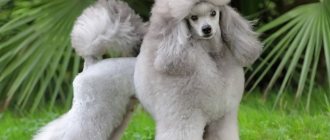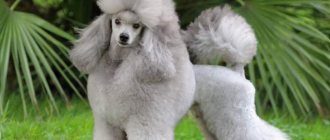Decorative small dogs are in great demand among modern people. However, you cannot make a choice in favor of a certain breed based only on the appearance of the future pet. It is necessary to thoroughly study the characteristics of the breed, weigh all the pros and cons, and only then purchase an animal. One of the most beautiful and interesting decorative breeds is the toy poodle. The representative of the family is distinguished by high intellectual abilities, good learning ability, excellent obedience, excellent socialization, and good character.
Brief history of origin
Toy poodles are descended from standard poodles. Three countries at once - France, Germany and Hungary - claimed the right to be considered their homeland.
Initially, they were quite large - the animals were used for hunting waterfowl. The ancestors are considered to be the North African Barbet and the Portuguese Water Dog. Dog experts suggest that the blood of Maltese, retrievers, pointers and greyhounds flows in the veins of poodles.
Selection took place in isolation in several countries, so the breed was divided into 4 groups differing in size. The smallest representative was the toy poodle.
French breeders developed the standard in 1936 - it was then that France was officially declared the homeland of animals. The document combined all types of poodles and classified them by height. Recognition of the IFF came later - in 1984.
From the history of the appearance of the breed
The smallest poodle was bred from a large poodle, which is considered standard and is not a decorative breed, but a service and sporting breed. Unlike the royal and medium, the toy poodle is a young breed that appeared only in the 20th century. The main goals of selection when breeding it were to reduce its size as much as possible and give it a particularly decorative appearance, so that the dog would resemble a charming toy. The latest FCI standard for the breed was registered in 2007.
By the way! There is a legend that the toy poodle was brought by sailors from Asian countries, but there is no official confirmation of this.
Interesting Facts
There are quite a lot of interesting things associated with the breed:
- Images of dogs resembling poodles were found on coins of Ancient Rome and Greece, in ancient tombs.
- Representatives of the breed served in Napoleon's army. The soldiers put dogs in backpacks so that if they were wounded, they would draw attention to the soldiers with a ringing bark.
- Composer Richard Wagner always took his beloved poodle to orchestra rehearsals. Hearing false notes, the pet began to bark.
- The breed was loved by many famous personalities: Prince Charles, Ludwig van Beethoven, Winston Churchill, Elvis Presley.
- Toy poodles were recruited into the Japanese police force. They work in a search and rescue team, since large dogs often cannot crawl under the rubble.
How to choose the right one so as not to make a mistake in price
Before you buy a puppy, arm yourself with patience and persistence. In order not to miscalculate the price and get a puppy that will suit you according to all the criteria described above, you can use several recommendations.
- Select several nurseries aimed at breeding poodles.
- Consult and find out how the price varies for a particular class, age and color of a toy poodle.
- Decide why you are buying a puppy; maybe you shouldn’t shell out such a significant amount for a pet. Are you sure that you will breed or show your dog in competitions?
- The most important criterion is the possibility of signing an agreement. This is a guarantee that he will take the dog back if problems arise.
On forums dedicated to this breed, there is an active discussion of the topic of nutrition. Beginning dog breeders are faced with the problem of allergic reactions caused by food. Typically, a tendency to food allergies is noticed by both adherents of natural nutrition and supporters of dry complex food . If you are the owner of a toy poodle and have encountered a similar problem, I would like to know your opinion. How do you overcome this illness?
Have you used medication? What foods or feeds does the reaction occur to? I would also like to know how much a king and mini poodle cost in your area? Are there breeders of the miniature poodle subspecies in your city and how much does a puppy cost? We look forward to your feedback and comments.
Breed description, standards and appearance
The Toy Poodle is the smallest representative of the breed. He is smart, active, harmoniously complex.
Adult dog sizes:
- height from 24 to 28 cm;
- weight 3–5 kg.
The ideal height at which dogs are rated as high as possible is 25 cm at the withers. Toy poodles less than 24 cm at the withers are disqualified.
The dimensions of the animal must correspond to the following proportions:
- the length of the muzzle is less than the length of the skull in the ratio of 9 to 10;
- rectangular body;
- the croup is almost at the level of the withers;
- The distance from the withers to the elbows is 4/9 of the height.
For your information. On the Internet, the breed is often called the “dwarf toy poodle.” This is fundamentally wrong. Toy poodles and toy poodles are different groups of dogs that differ in size.
Description of the breed (ICF standard No. 172):
- The head is graceful, not too thin, not too massive, in harmony with the body.
- The skull is moderately wide (less than ½ the length of the head), slightly convex. The brow ridges are clearly visible and covered with long fur. The occipital protuberance is clearly pronounced. The stop is smoothed, but never completely absent.
- The nostrils are open, the lobe is pigmented in accordance with the color of the animal. For black, silver, and white dogs it is black, for chocolate dogs it is brown, for red dogs it is black or brown, for light red dogs the darkest color possible is encouraged. A depigmented lobe is a disqualifying defect.
- The muzzle is strong, the back of the nose is smooth, without humps.
- The lips are moderately thick, closer to dry, painted in the same colors as the lobe. The top touches the bottom, but does not cover it.
- The jaws are closed in a scissor bite. Dogs with overshot or underbite are disqualified.
- The eyes are almond-shaped, slightly slanted, and located at the level of the stop. The color of the iris is dark brown; in chocolate dogs, dark amber pigmentation is acceptable. The look reflects the character of the toy poodle - friendliness and activity.
- The ears are long, hanging, with rounded tips. Widened at the bottom. Covered with wavy and long hair. If you pull your ear forward, it should reach the corner of your lips, or better yet, overlap it.
- The neck is strong, ensures a proud and high carriage of the head, the scruff protrudes slightly. The length is slightly less than the distance from the tip of the nose to the occipital protuberance. There is no suspension.
- The back and loin are strong, the croup is rounded but not sloping.
- The chest is lowered to the elbows, the depth is 1/3 of the width. The belly is moderately tucked.
- The tail sits quite high. Tailless or bob-tailed dogs are subject to disqualification.
- The limbs are muscular, smooth and parallel. The paws are compact, oval, the toes are gathered into a ball.
The nature of the toy poodle's movements is light and springy. The dog should not run too smoothly or stretched out. From the outside it seems as if the dog is not making any effort.
Important. Toy poodles with an aggressive or cowardly nature, as well as dogs with obvious anomalies in physical structure or behavior, are subject to disqualification.
List of nicknames
For an original mini-dog, choose a name that suits its appearance or character. It is necessary to avoid long words with a lot of consonants that sound rude. Pets are often called affectionately, tenderly, or with exotic intonations.
Common nicknames for male dogs: Arto, Arsen, Archie, Buckley, Basil, Barney, Waltz, Harry, Count, Dustin, Jazz, Zhulbert, Fuse, Zigmund, Zorik, Indigo, Lucky, Lel, Lawrence, Mike, Nils, Nord, Olaf , Orpheus, Austin, Paco, Pele, Peach, Rice, Sally, Tonic, Fidel, Elvis, Janek.
Names for females: Agata, Adele, Assol, Alisa, Alma, Amalia, Beata, Bella, Businka, Valerie, Vega, Viola, Gabi, Glasha, Denise, Diana, Dina, Dora, Eva, Giselle, Zara, Zizi, Zita, Toffee, Lada, Laura, Lucy, Nicole, Richie, Selina, Tori, Ulya, Utah.
What is the difference between a toy poodle and a miniature poodle?
The main difference between a toy poodle and a toy poodle is height. The height of the first is 24–28 cm, the second is 28–35 cm. Another difference that is noticeable only to experts is the degree of expression of the occipital protuberance. In a toy poodle it may be slightly different - a little less noticeable.
However, other signs of dwarfism (sharp stop, spherical skull, snub muzzle) are excluded. Otherwise, the dogs are small copies of their larger counterparts, have the same proportions and are judged to the same standard.
Reproduction and lifespan
The miniature poodle has joined the ranks of long-lived dogs. With proper nutrition and good care, he will live at least 15-16 years. The breeder must be able to distinguish a miniature poodle from a toy. They are very similar, but still different. It is advisable to breed individuals of the same breed species. It is important that they are not related to each other, since in this case they will not have to wait for healthy offspring.
It is necessary to count the date favorable for conceiving offspring and take the bitch to the male on the 3rd day of her heat. She gives birth to from 1 to 6 puppies. Childbirth can be complicated, so when she starts having contractions, we recommend calling a veterinarian.
Varieties
The breed is not officially divided into varieties. However, in Japan, small dogs were bred, 22–24 cm tall and weighing up to 3 kg, which were called the “Japanese toy poodle”. They are a genetic mutation and are considered defective.
The Japanese Toy Poodle cannot participate in exhibitions or breeding. Tiny dogs require even more careful care because they have weak skeletons and are prone to a whole bunch of diseases.
However, the Japanese Toy Poodle has the same friendly and positive personality. Following fashion trends, people keep him as a pet, despite possible problems.
There is also a detailed article about the Poodle dog breed.
Color and coat type
The Toy Poodle's body is covered with elastic and well-pigmented skin. In white dogs it is silver in color, in animals of all other colors it corresponds to the color.
Representatives of the breed can have two types of fur:
- Curly – elastic, with pronounced curls.
- Corded - the wool is divided into separate strands (so-called cords) at least 20 cm long.
The spine should be fine in structure, and the coat should be thick and fluffy. Sparse, flabby, hard fur is a serious drawback.
Allowed colors:
- Black is a classic color without any admixture of gray or brown.
- White – Dogs may be apricot or cream at birth, but after molting the color becomes uniform.
- Brown – rich, warm, uniform without beige or lighter tones.
- Gray is not close to black or whitish. Includes a range of gray, blue and silver shades.
- Red (red) - the dog can be light red, orange (apricot) or red in color. With age, the coat lightens and becomes less vibrant.
Important. Toy poodles with white markings in colored coats are disqualified.
In 2008, the RKF recognized two more colors - harlequin (black and white) and black and tan. Now such dogs are considered separate breeds: harlequin and phantom. They are not yet recognized by the FCI, but they are successfully bred in the USA, Germany, Austria, and the Czech Republic.
Training and education
The toy poodle is smart and has a good memory. That is why raising and training him is not difficult. Of course, a small pet does not need watchdog or security skills, but it must learn basic commands and rules of behavior.
Raising a poodle begins from puppyhood. We begin teaching our pet more serious commands from the age of four months.
Plan your lessons in a playful way. There must be variety, consistency and rewards. Physical punishment is excluded. The poodle, being a naturally affectionate dog, does not tolerate rudeness, shouting, or any manifestation of aggression.
Interesting Facts
- The poodle is very fond of people and not very fond of dogs.
- The uniqueness of the poodle's coat lies not only in its similarity to sheep's wool, but also the hair of the representatives of the breed is distributed evenly over all parts of the body, its length is the same on the tail, on the muzzle, and on the back.
- The name "poodle" comes from the German "pudel-nass", which translated means "soaked to the skin."
- The “toy” part of the name means “toy” in English.
- Poodles were Marie Antoinette's favorite dogs; they lived at court and had their own servants.
- The Toy Poodle's coat quickly and easily curls into felt. There are farms that specialize in raising poodles for their wool, which is used to make warm clothing.
Character and behavior
Mini poodles are smart, noble, and loyal to their owner. They become strongly attached to people and do not tolerate loneliness well. Given these character traits, the breed should not be owned by a busy person. But if you give your dog enough attention, it will reveal all its positive qualities.
Toy poodles feel the mood of people, know how to be happy and sad with them. The breed is not at all aggressive, is easy to train, loves to play and have fun. But constant entertainment can become a source of additional noise - owners should be prepared for frequent loud barking.
The breed is indifferent to other dogs. But in relation to small pets, it can exhibit a hunting instinct. Well-mannered toy poodles get along well with children, but a small dog is very easy to injure - playing together should only take place under adult supervision.
Taking into account the nature of the breed, the Toy Poodle is suitable for an active person who can devote a lot of time to it. It is better not to leave the dog alone for a long time. But if such a need does arise, you should provide the dog with a variety of toys so that he can entertain himself.
Breed traits
Breed traits (on a 5-point scale)
| Toy poodle | |||
| Activity | in the house | 3.2 | |
| on the street | 3.2 | ||
| Obedience | training | 4.1 | |
| strangers | 4 | ||
| Domination | in family | 1.9 | |
| over dogs | 2.7 | ||
| Defending your territory | from people | 2.6 | |
| from dogs | 2.9 | ||
| Sociability | in family | 4.8 | |
| with strangers | 3.8 | ||
| with dogs | 3 | ||
| Concentration | in family | 1.2 | |
| in front of strangers | 1.7 | ||
| with dogs | 1.5 | ||
| Aggressiveness | in family | 1.3 | |
| to strangers | 1.8 | ||
| to the dogs | 2.4 | ||
| to cats | 2.3 | ||
| Family behavior | calmness | 4.4 | |
| demand for affection | 5 | ||
| excitability | 4.3 | ||
| playfulness | 4.3 | ||
| excessive barking | 2.6 | ||
| behavioral breakdowns | 1.7 | ||
| Tolerance for children | up to 4 years | 2.9 | |
| over 4 years old | 3.6 | ||
| Institutional use | watchman | 4.5 | |
| bodyguard | 2.4 | ||
This breed is often compared to the following dog breeds: Bichon Frize, Pomeranian, Yorkshire Terrier, Maltese (Maltese Bichon), Papillon.
The photo shows what a toy poodle looks like:
Appearance of a Toy Poodle dog
How to choose the right puppy?
In childhood, toy poodles cannot be distinguished from larger varieties, so it is better to buy puppies from nurseries that have proven themselves on the positive side. Before purchasing, you should learn more about the nature of the breed, visit exhibitions, and communicate with current owners.
A responsible breeder will be happy to talk about his charges and inform about the characteristics of each of them - the puppies are always distinguished by their quality. He will not refuse to meet his parents. Dogs must have good conformation, behave in a balanced and friendly manner. Defects not only in appearance, but also in character are inherited.
After examining the litter, you should choose the most active and nimble baby.
His health is evidenced by:
- clear eyes;
- skin without redness or ulcers;
- a neat fur coat without an unpleasant odor;
- a body without any traces of excess weight or exhaustion.
The fact of purchase should be confirmed by a purchase and sale agreement in order to protect yourself from purchasing a mixed breed or a sick dog. Along with the document, the breeder must give the new owner a veterinary passport and the puppy’s birth certificate, which is subsequently changed to the pedigree.
Price
Only the breeder from the nursery will provide you with a guarantee that the dog fully complies with the accepted international standard. Therefore, if you would like to take your pet to show exhibitions in the future, be sure to purchase a pedigree for it.
The price of a miniature poodle with documents from the nursery is from 7 to 15 thousand rubles. Some breeders artificially inflate the cost of these dogs, selling them for more than 30 thousand rubles. We do not recommend working with them!
Puppies
A mother dog can feed her puppies milk for about 60 days. Around the middle of this period, babies begin to be fed with low-fat cottage cheese, yogurt or kefir, egg yolk, grated apples, and finely chopped boiled beef.
In the new home, the toy poodle continues to be given the usual food - the slightest changes in the diet are fraught with digestive problems. You can gradually switch your puppy to ready-made food appropriate for his age. The transition takes at least two weeks.
With a natural diet, the diet is supplemented with:
- rice or buckwheat porridges cooked with milk or meat;
- vegetables - carrots, cucumbers, pumpkin;
- fresh herbs - spinach, dill, parsley, dandelion leaves.
At 4 months, sea fish is included in the menu. Puppies are given only fillet, thoroughly cleaned of bones. At the same time, by-products are introduced into the diet - liver, lung, tripe. When teeth change, the amount of fermented milk products rich in calcium is increased. To make the process easier, dogs are periodically allowed to chew sugar seeds.
At 6 months, a toy poodle eats an adult menu, but the total amount of food should be slightly larger as the pet continues to grow. The serving size is calculated individually, based on the baby’s needs. If the dog greedily licks the bowl, give a little more food. If the dog does not eat food within 20 minutes, the amount of food is slightly reduced.
Toy poodle feeding frequency per day:
- 1–2 months – 5 times;
- 2–5 months – 4 times;
- 5–7 months – 3 times.
From the age of 8 months, a toy poodle receives food like an adult dog - twice a day.
Dog food
When choosing a diet for a poodle, they are guided by the type of food to which the puppy was accustomed to by the breeder. This will help avoid problems with your pet's adaptation.
The most convenient option for a dog is to use ready-made balanced dry or wet food complexes. Be sure to study the instructions, which indicate the types of dogs for which they are produced. The recommended daily dosage is observed when feeding a toy poodle. The dog must always have access to clean water.
When compiling a natural menu, the pet is given lean boiled meat every day, which makes up half of the diet - turkey, chicken, beef. To provide the dog's body with useful elements, add rice porridge, oatmeal, buckwheat, lightly flavored with vegetable oil.
Vegetables are introduced into the dog’s diet, except legumes and potatoes. Twice a week, the dog is given boiled sea fish instead of meat. Enrich the poodle’s nutrition with vitamin and mineral complexes after consultation with a veterinarian. Bananas or apples are used as treats to encourage your pet. The dog is allowed an egg every 4 days.
Expert opinion
Anna Abramenko
An avid dog lover. Experience in veterinary medicine since 2009.
Ask a Question
Puppies are given food in small portions up to 5 times a day. Adult dogs are fed morning and evening.
Care and maintenance
The toy poodle is a compact decorative breed for apartment living. The pet is given its own corner away from drafts and heating devices - they equip a bed and put their favorite toys nearby. Bowls with food and water are placed in another place.
The dog requires careful care - regular physical activity and hygiene, haircuts, and a balanced diet.
The right diet
Toy poodles are suitable for 2 feeding schemes: natural food and ready-made food.
Many dog breeders prefer industrial products of premium, super-premium or holistic classes because they:
- fully meets the needs of the body;
- eliminates the need to introduce additional additives;
- saves time.
This option is ideal for owners of show-class toy poodles who often travel to shows and are rarely at home.
With natural feeding, the dog’s diet includes:
- lean meat and offal;
- buckwheat, rice, oatmeal, millet porridges;
- dairy products;
- fresh vegetables and herbs;
- chicken eggs (once every 4 days).
Twice a week, fish porridges are prepared instead of meat porridges. Fruits (bananas, apples, pears) are given as treats. To improve the structure of the coat, add 1 tbsp to food. l. vegetable oil.
Walking and exercise
The characteristics of the breed indicate the activity of toy poodles - they love to walk and frolic. In summer, kids will not refuse to swim in the pond. The dog needs to be walked twice, or preferably three times a day for at least 20 minutes. It is advisable that the dog can run without a leash during at least one walk.
On a note. During the cold season, dogs are taken outside in overalls to avoid hypothermia. In bad weather, it is allowed to leave animals at home if they are accustomed to relieve themselves in a litter box.
Training and education
Despite their small size, toy poodles have a wayward character and require proper training and socialization.
After moving to a new home, the puppy is given several days to adapt, after which it is taught:
- respond to name;
- relax and sleep on a bed;
- relieve yourself on the street or in a tray;
- walk with a collar and leash.
On walks, the dog is introduced to new people, smells, sounds, and other animals. Gradually, the baby is taken to increasingly busier places. The puppy learns to behave adequately in any situation and not be afraid of the world around him. Without proper socialization, pets grow up to be cowardly, aggressive and uncontrollable.
At 4 months they begin training.
The most important commands:
- complex “Sit!”, “Lie down!”, “Stand!”;
- "Ugh!";
- "It is forbidden!";
- "To me!";
- “Go for a walk!”;
- "Place!".
Since the breed is prone to barking for no reason, it will be useful to learn the command “Silence!”
Training is built sequentially, moving from simple to complex.
Once the basic skills have been mastered:
- begin endurance training;
- Gestures are added to verbal orders;
- are taught to perform the required actions at a distance.
With the onset of puberty (after 6 months), a toy poodle may deliberately not respond to commands in order to test the owner’s reaction and the boundaries of what is permitted.
In this case, it is allowed to punish the dog:
- change the intonation to strict and reprimand;
- select your favorite toy;
- completely ignore the animal;
- lock the toy poodle in another room for a while.
The dog must understand that disobedience always results in punishment. If you act methodically and strictly, her behavior will soon normalize and her character flaws will be corrected.
In the future, the toy poodle can be taught various tricks:
- give paw;
- show the bunny (sit on the butt);
- walk between your legs, etc.
Each correctly performed action is reinforced with a treat and sincere praise, stimulating the desire to learn.
Care and hygiene
The Toy Poodle's thick fur is brushed daily, even if it is cut short. Bathing is required less frequently - approximately once every 2 months. After each walk, wash the paws and wipe off dirt on the body with a damp cloth.
For your information. One of the advantages of the breed is imperceptible shedding. A small amount of hair falls out constantly. They are easy to remove by combing.
Toy poodles are regularly clipped for hygienic or decorative purposes.
In the first case, the hair is shaved:
- on the face;
- inside the ears;
- in the groin;
- on the genitals;
- at the base of the tail;
- on the paws.
Decorative hairstyles can be very different. Haircuts for show toy poodles are regulated by the standard:
- “Lion” - the hair is shortened from the hind legs to the ribs, on the muzzle, cheeks, tail, and front legs. Cuffs are left on the limbs, and a pompom on the tail. The forelimbs are allowed not to be cut, leaving the so-called trousers.
- “Modern” - involves cutting the front paws from the ground to the dewclaw, and the hind paws to the same level. On the muzzle, the hair is shortened in the same way as with the “Lion” haircut. It is permissible to leave a beard no longer than 1 cm on the lower jaw. There is no need to make a pompom on the tail. The length of the fur on the body is evened out or the hair of different lengths is left depending on the type of hairstyle.
- “English haircut” is very similar to “Leo”. The front part of the body is cut in almost the same way. Short hair is left in the groin, croup and lower back; a pompom is made on the upper two-thirds of the tail.
- “Pappy clip” - a ball is formed from the fur on the front part of the body, and the fur on the muzzle, paws, and base of the tail is shaved off. A crown of reasonable height is left on the head.
- “Scandinavian clip or Terrier haircut” is almost identical to the “Modern” haircut with the difference that the ears and tail can be shaved.
Other types of hairstyles - bichon, lamb, kennel, etc. - are considered domestic. It is better to entrust the haircut to a professional groomer, so as not to spoil the appearance of the toy poodle.
Breed care includes:
- cleaning your ears and teeth once a week;
- rubbing the eyes when discharge appears with an antiseptic solution;
- trimming nails once a month if the dog does not wear them off naturally;
- treatment against worms and blood-sucking parasites every 3 months.
A toy poodle is taught hygiene procedures from early childhood so that, as an adult, he does not resist and does not show character.
Health and illness
Small breed dogs often suffer from diseases. The toy poodle is most susceptible to several pathologies.
- Fusion of the nasal passages. The defect is congenital. The dog has severe snoring and difficulty breathing. Treatment is surgical.
- Pathologies of the cardiovascular system. To reduce the risk of disease, your pet should be protected from stress and not subjected to physical exertion.
- Eye diseases. The most common group of diseases found in poodles of various varieties. Most often, dogs are diagnosed with conjunctivitis, cataracts, glaucoma, retinal atrophy, and entropion. Almost all diseases have a genetic predisposition, and their treatment is of little effectiveness. It is not uncommon for older poodles to have poor vision or become completely blind.
- Epilepsy. It is usually diagnosed in puppies and can either progress or go into a state of stable remission throughout life. The pathology is hereditary in nature, which is mainly associated with the high nervous excitability of the animal.
- Diabetes. The pancreas of all toy dogs is quite weak. Genetic predisposition plays the main role here. Eating disorders significantly increase the risk of developing the disease. Supportive therapy was adopted.
- Diseases of the mouth. Toy poodles often suffer from gingivitis and ulcerative stomatitis as they age. The main causes of these diseases are poor nutrition and insufficient oral care. Regular tartar removal, a balanced diet and preventative visits to the veterinarian will help avoid problems.
- Otitis. The disease is mainly related to the shape of the ears. Long and hanging, they do not allow the internal funnels to be fully ventilated, and if water gets into them, they prevent it from flowing out. The dog easily develops inflammation (purulent or non-purulent). The main preventative measure against otitis media is proper ear hygiene.
- Urolithiasis disease. Metabolic disorders are common to all dwarf dogs. They cause the accumulation of salts and improper removal from the body, causing the appearance of stones in the kidneys, ureter and bladder.
Small breeds are highly susceptible to viral pathologies, which is why strict adherence to the vaccination schedule and the quarantine period after them is necessary. During the first 12 months of life, the puppy receives 3 vaccinations, then vaccinations are given once every year.
Lifespan
Despite its delicate health, the small poodle is a long-lived dog. If the owner follows all recommendations for keeping and feeding the pet, it can live up to 16 years. It is not uncommon for a dog, if it has not suffered from viral infections, to live for 18 years. To maintain health, older poodles require a more fortified diet, and they also need to visit the veterinarian regularly (at least once every 3 months).
Vaccinations and susceptibility to disease
At 7–8 weeks, toy poodle puppies receive their first vaccinations against the most common diseases:
- plague;
- parainfluenza;
- parvovirus enteritis;
- hepatitis A;
- leptospirosis.
10 days before vaccination, dogs are treated against fleas and ticks. After about 21 days, pets are vaccinated again to strengthen immunity, with the addition of a rabies vaccine. The veterinarian can adjust the schedule based on the individual characteristics of the puppy and the infectious situation in a certain area. Adult animals are vaccinated annually.
The Toy Poodle dog breed is prone to many diseases, including:
- diabetes;
- epilepsy;
- urolithiasis disease;
- hypothyroidism;
- pathological hair loss (alopecia);
- tonsillitis;
- non-closure of the ductus Botallova;
- Gelineau's disease;
- microphthalmia;
- cataract;
- Addison's disease;
- blood clotting disorder;
- dislocated kneecaps.
Older dogs often go blind and deaf. Toy poodles are very fragile, so they often get injured.
On a note. The breed has an easily excitable character, so neuroses are common among its representatives. If the skin is inflamed and the dog is actively licking itself and biting itself, you should consult a veterinarian.
Life expectancy of a toy poodle
Small dogs usually live longer than large ones – the toy poodle is no exception. Despite the predisposition to many pathologies, the average life expectancy of the breed is about 15 years. With careful care and good heredity, the dog will live 2-3 years longer.
On a note. It is a common belief that male poodles live longer than female poodles. However, the lifespan of a dog does not depend on gender.
Reviews
Interesting information can be obtained from owners of unique miniature dogs:
Nonna. St. Petersburg: “Knowing about my allergy to wool, I chose a toy poodle consciously. A year later, I can state that this is a miracle, giving only positive things to the family. After communicating with a pet, performance increases and mood improves.”
Ulya. Saratov: “My little pet is three years old. We give our toy poodle a haircut every two months, turning him into a spectacular lion cub. No one remains indifferent. We rarely take part in dog shows, but we always take prizes. Most importantly, our pet quickly became a selflessly loyal and devoted friend to all family members.”
Ksenia. Pskov: “We contacted the nursery without yet knowing what breed we wanted. When we saw the tiny, curious toy poodle puppies, we couldn’t pass them by. At home, our Leo quickly settled in. The dog does not confuse the toilet with a bed. True, you have to hide your shoes from your pet. The poodle plays with pleasure, but does not like to walk for a long time.”
Pros and cons of the breed
| pros | Minuses |
| People-oriented | Tendency to a number of diseases |
| Friendly character | Loud barking |
| Beautiful appearance | High injury rate |
| Learning ability | Difficult care |
| Compact dimensions | |
| Hypoallergenic wool | |
| Lack of aggression |
The Toy Poodle resembles a stuffed animal, but in reality it is an intelligent and loyal dog with a distinct personality.
The breed is equally well suited for both single and family people - the main thing is that the owner pays enough attention to the pet.
Photo and video review
Toy poodles, although small and compact, are not just decorative toys. These are smart dogs, true true friends, devoted companions. With decent maintenance and proper care, pets bring only positive emotions into the home. Photos allow you to evaluate in detail the external characteristics of graceful toy poodles. Of interest is the variety of colors of the breed. You can analyze the types of haircuts. This makes it easier to select options. Videos demonstrate the intricacies of dog training.
How to determine age?
The most accurate way is to determine the age of the animal's teeth.
Young dogs, 1-2 years old, have snow-white and sharp teeth, and their protrusions are shaped like a trefoil. After the poodle turns 2 years old, the ridges on the teeth begin to gradually wear out, but they themselves retain their snow-white color.
By the age of four, the teeth of representatives of this breed become dull: they acquire a grayish tint, and the protrusions on them are almost completely erased.
In five-year-old poodles, the canines become less sharp, and the teeth themselves begin to turn yellow.
By the age of 6-8 years, the canines are already completely dull, and the edges of the incisors begin to become concave. At this time, increased formation and hardening of plaque on the teeth may also begin, which, if not properly cared for, can turn into tartar.
By the age of 8-10 years, a poodle's teeth become completely yellow. Sometimes they can even turn brownish in color. By this age, the fangs already look very worn out, and the toes look oval.
In twelve-year-old poodles, the teeth gradually begin to loosen, which can lead to the loss of some of them and damage to the bite.
NOTE!
You can also try to determine the approximate age of a poodle in other ways: by fur, eyes, energy and general condition of the animal.
Thus, young dogs of this breed have soft and thick hair, arranged in beautiful curls or curled into thin cords that hold their shape well. In older poodles, it becomes dull, more brittle, and less easy to style. Also, older dogs begin to turn gray.
Poodles' eyes are bright and shiny when young, but at about 7 years of age they become slightly dull and appear more deep-set.
Young poodles are active and playful. Older dogs prefer to rest more, they run less and play less.
The muscles of young poodles are elastic, but as they age they become more flabby. In addition, obesity can develop due to insufficient physical activity.
Age compared to humans
| Poodle age | Person's age |
| 1 year | 15 years |
| 2 years | 24 years |
| 3 years | 28 years |
| 4 years | 32 years |
| 5 years | 36 years |
| 6 years | 42 years |
| 7 years | 47 years old |
| 8 years | 51 years old |
| 9 years | 56 years old |
| 10 years | 60 years |
| 11 years | 65 years old |
| 12 years | 69 years old |
| 13 years | 74 years old |
| 14 years | 78 years old |
| 15 years | 83 years old |
| 16 years | 87 years old |
Historical reference
Toy's ancestor is a large standard poodle, which gained popularity among nobles at the court of Queen Marie Antoinette of France.
The favorites of the aristocracy appeared as a result of crossing two breeds - the German shepherd (sheep poodle) and the Spanish (water poodle). They were initially considered hunting animals, but over time they began to spend more and more time at balls rather than in the swamps. Let us remember that the French lapdogs and papillons were also favorites of the French aristocracy.
Although the breed has not been around for very long, it has successfully passed the standardization procedure at the regional and international levels.











